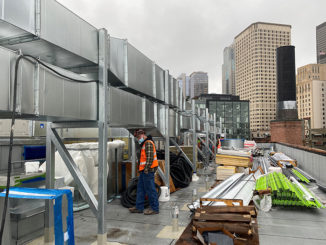
Reciprocal mentorship and coaching programs are key to strong labor-management partnerships
By / Jordan Whitehouse
At the 2020 Partners In Progress Conference, SMART General President Joseph Sellers, Jr. took to the stage to talk about leadership. While the forum touched on a range of themes, Sellers underlined the importance of mentorship. “Our personal challenge is leadership and mentoring,” he said, stressing that mentorship is key in affecting positive change across the industry in the United States and Canada.
It was an interesting comment, and not one typically heard today, when in-class, online, and apprenticeship learning usually take precedence over any type of one-on-one mentoring or coaching. But there are signs that’s changing, or at least that more personal forms of training are considered important tools in developing competent, capable workers and future leaders. In a study titled, “Mentoring and Coaching Practices: Developing the Next Generation,” published by The New Horizons Foundation, 87% of executives and managers surveyed said they would “possibly” or “definitely” participate in a mentoring or coaching program.
So, if mentoring and coaching programs are so important today, why? What does good mentorship even look like? And how can labor and management work together to implement these programs?
The New Horizons study tries to provide some answers, and it begins by distinguishing between mentoring and coaching, which are sometimes used interchangeably. While both offer one-on-one guidance, the mentor is usually inside the organization, while the coach is usually an expert outside of it. Coaching is also generally focused on developing specific skills that could be applied to many companies, while mentoring is more about developing relationships that might help the mentee navigate her specific company.
One thing coaching and mentoring do have in common, though, is their lack of popularity in the sheet metal industry. The New Horizons study found that over 80% of respondents’ organizations had neither a mentoring or coaching program.
There are likely a few reasons for that, particularly in recent years, says Guy Gast, president of Waldinger’s – Iowa division and past president of SMACNA. For one, the generation retiring from the industry is taking with them the soft skills they developed over the years that are necessary for good mentorship, he says. At the same time, the recent technological shift across the industry puts many at a similar level of understanding. “While we can certainly see older workers adopting technology readily and quickly, the comfort level that people develop from mentoring programs comes from honing lifelong skills,” he says.
That doesn’t mean there aren’t excellent reasons for developing mentorship programs, he adds. In fact, they may be needed now more than ever to deal with the types of major technological and generational challenges the industry has seen in recent years.
One of those challenges is finding competent, capable workers—especially younger employees, the ones critical to the long-term success of the industry. But as the New Horizons study points out, mentorships may be one good way to attract those younger, Millennial employees because mentorships can help people find greater meaning in their work, something very important to this generation. SMACNA President Angie Simon agrees, and says those mentored employees could even be your best recruiters. “This is a generation that, if you can include them and mentor them, help them, pay attention to them, they’re going to share that story with their friends who are maybe working at a restaurant or wherever,” she says. “They’re going to share the story that this is a pretty cool place to work.”
Another upside of developing mentorship programs is that they can help foster good working relationships between labor and management. “It’s something that labor and management can and should partner on,” says Gast. “Not all training has to be delivered in a bricks-and-mortar environment. Anything that we can do to partner more in a local marketplace to universally deploy training is good because our people do move around from shop to shop. Part of the attraction of a union workforce isn’t just the availability or the skillset, but it’s the experience a customer has.”
So, to ensure successful mentorship programs? The New Horizons study suggests establishing clear goals and objectives between the mentor and mentee at the outset, monitoring mentee progress throughout the program, and evaluating the mentorship program regularly.
Angie Simon also believes collaboration between management and labor is key. At Western Allied Mechanical, Simon has regular mentoring sessions with future stockholders in the company who, in turn, mentor junior employees. That program proved so successful that Western proposed it to their partners at Local 104 and now every foreperson mentors a junior employee in the field.
Simon also believes that good mentorship starts with a firm commitment from the top. “Top management has to say they want to be involved, and they have to make it happen. They have to say to themselves, ‘I have an hour set up here for mentoring, and I am not going to miss it come hell or high water.’”
But Simon has also found that mentoring doesn’t always go one way, and says that because we are in a time of such profound technological change, younger employees comfortable with that technology can guide older generations making the mentorship reciprocal. Joseph Sellers, Jr. echoed something similar at Partners In Progress: “It’s amazing what you learn as a mentor. It’s a two-way street. I have learned throughout the years how to be better from others and from being a mentor.”
Bottom line, said Sellers, nimble training is so important across the industry right now, and mentorship and coaching programs can be a key part of that training. “We want to make sure our members are well prepared when the call for work comes in.” ■



